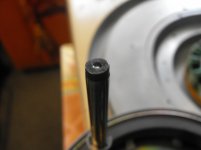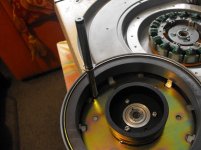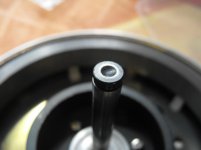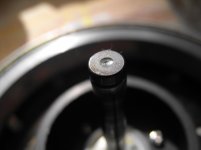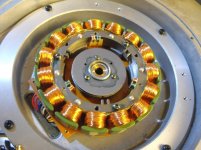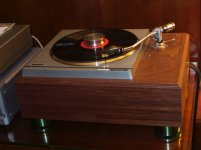I'd suppose that having an oil well for the SL-1200 bearing and the right oil would make more difference than torlon on the bearing surface.
The original oil was very low creep, as it had to stay put and not flow away from the original surface, which is completely open.
I've got an oil well bearing for my SL-1200, and it is an improvement.
Some of the aftermarket bearings, although impressively machined and well engineered, which would undoubtedly make a good and positive difference, cost as much or more than a working SP-10 in need of a restoration...
I have a wonderful SL-1200, modded to a beautiful degree*, and with a Graham tonearm. It's absolutely fantastic, so very much better than stock. Supremely musical, I thought it would be difficult to improve upon it, not as in "can the SL-1200 get any better", but "I've never heard a turntable as good as this!" 🙂 🙂 🙂
My SP-10 blows it cleanly out of the water. There's no comparison, they are not in the same league at all. (And remember, I have identical arms on the SL- and the SP- )
In my opinion, the outlay for an expensive bearing is money poorly spent. It's too much of the cost of a SP-10.
* SL-1200 mods - Outboard PSU, upgrade regulator, oil well bearing, Isonone feet, Acromat, Graham2.2 tonearm.
The original oil was very low creep, as it had to stay put and not flow away from the original surface, which is completely open.
I've got an oil well bearing for my SL-1200, and it is an improvement.
Some of the aftermarket bearings, although impressively machined and well engineered, which would undoubtedly make a good and positive difference, cost as much or more than a working SP-10 in need of a restoration...
I have a wonderful SL-1200, modded to a beautiful degree*, and with a Graham tonearm. It's absolutely fantastic, so very much better than stock. Supremely musical, I thought it would be difficult to improve upon it, not as in "can the SL-1200 get any better", but "I've never heard a turntable as good as this!" 🙂 🙂 🙂
My SP-10 blows it cleanly out of the water. There's no comparison, they are not in the same league at all. (And remember, I have identical arms on the SL- and the SP- )
In my opinion, the outlay for an expensive bearing is money poorly spent. It's too much of the cost of a SP-10.
* SL-1200 mods - Outboard PSU, upgrade regulator, oil well bearing, Isonone feet, Acromat, Graham2.2 tonearm.
Not after you have put it into a lathe ?though seemingly our views about the shape of 'small discs' differ slightly
Dave
I just looked at a 1200 bearing that I have, I am not sure that the Torlon is a good idea. The 1200 bearing I looked at is new, so I could not seee what the wear looks like on a well worn 1200 thrust plate. I did see the thin hardened steel plate. Thrust bearings consist not oly of the pad, but of the 'tip' that rides on it. These materials and their hardnesses are not chosen at random, it is engineered. I did not look closely at the 1200 bearing, so it could be a candidate for a Torlon thrust pad, though if so, I think it would be best with a new metal plate, and a re-design.
Meanwhile, I might be tempted to leave it alone, and if it is really worn, to get a complete new bearing assembly. They are not expensive, or at least, they were not when I bought mine.
Meanwhile, I might be tempted to leave it alone, and if it is really worn, to get a complete new bearing assembly. They are not expensive, or at least, they were not when I bought mine.
A loose bearing issue
I am checking all my SP10 mkII thrust bearings for wear. This one is not too bad but still will be replaced. It has another issue. I bought it cheap for spares with the power supply cable cut off at the chassis, and no power supply. It had a poor paint job sometime previously but the boards all seem to be working. I found that the motor shaft was loose in the rotor and spinning freely. From the look of the thrust bearing, brake belt and motor shaft, it is not a high use sample. I will fit a new Torlon thrust bearing and re-fix the shaft with Loctite. It looks like the oil lubrication exit hole is quite close to the top of the shaft. Maybe over generous lubrication oil can migrate up the shaft and loosen the press fit. Just speculating.Here are before and after pictures of the thrust bearing for one of my SP10's. The images says it all. The motor date is 1978.
Attachments
....and re-fix the shaft with Loctite.
Hi Bon,
If you use Loctite in that application, I'd recommend bearing retaining compound; in the unlikely event that you need to separate the two surfaces, bearing retaining compound is designed to facilitate removal. Thread lock in this application will be permanent!
Regards,
Phil
An externally hosted image should be here but it was not working when we last tested it.
I have a motor with the same problem. Except that this one was used over a period of time to the extent that there is ware in the sleeve of the cast motor chassis, such that the platter could rock. This will require re-fitting of the bearing, and will need either a completely new custom bearing or a sleeve over the old one.
I found that the motor shaft was loose in the rotor and spinning freely. From the look of the thrust bearing, brake belt and motor shaft, it is not a high use sample. I will fit a new Torlon thrust bearing and re-fix the shaft with Loctite. It looks like the oil lubrication exit hole is quite close to the top of the shaft. Maybe over generous lubrication oil can migrate up the shaft and loosen the press fit. Just speculating.
Thanks for the advice. I was just about to use the 609 Super Retaining Compound “especially suitable for permanent assemblies”.Hi Bon,
If you use Loctite in that application, I'd recommend bearing retaining compound; in the unlikely event that you need to separate the two surfaces, bearing retaining compound is designed to facilitate removal. Thread lock in this application will be permanent!
Regards,
Phil
An externally hosted image should be here but it was not working when we last tested it.
Although I don’t envisage dis-assembling the shaft, someone else further down the track might be so inclined. It would be advisable to leave that option open.
BTW Loctite is not cheap!! At least not in oz.
One mine the shaft does not rock in the bearing sleeve but there is slight rock in the loose rotor/shaft join. I am hoping the locking compound will fix this with negligible tilt.I have a motor with the same problem. Except that this one was used over a period of time to the extent that there is ware in the sleeve of the cast motor chassis, such that the platter could rock.
So, too, in mine. The bearing seemed fine after I freed the shaft and oiled it.
One mine the shaft does not rock in the bearing sleeve but there is slight rock in the loose rotor/shaft join. I am hoping the locking compound will fix this with negligible tilt.
....but there is slight rock in the loose rotor/shaft join.
Hi again Bon. This is another advantage of 641 bearing mount compound; it is designed to be used with worn or damaged shafts/bearing surfaces. So, as long as you can true it up while the compound sets, it should be good to go. There is another Loctite product for even more worn surfaces, but it would be overkill in this application.
Regards,
Phil
I'm so glad to hear this!
This is another advantage of 641 bearing mount compound; it is designed to be used with worn or damaged shafts/bearing surfaces. So, as long as you can true it up while the compound sets, it should be good to go.
Hi Shaun,
Yeah, it's handy stuff, and if you make a boo-boo you can clean it out and start afresh.
I first used it with a tonearm's bayonet headshell socket. The two machine screws that hold it in place had slowly enlarged the holes in the softer aluminium tonearm tube. I actually did have to have another go at it, as the azimuth was not correct the first time around. So, I can confirm that it can be re-done!
Regards,
Phil
Yeah, it's handy stuff, and if you make a boo-boo you can clean it out and start afresh.
I first used it with a tonearm's bayonet headshell socket. The two machine screws that hold it in place had slowly enlarged the holes in the softer aluminium tonearm tube. I actually did have to have another go at it, as the azimuth was not correct the first time around. So, I can confirm that it can be re-done!
Regards,
Phil
An externally hosted image should be here but it was not working when we last tested it.
An externally hosted image should be here but it was not working when we last tested it.
An externally hosted image should be here but it was not working when we last tested it.
This is my third thrust bearing check. This sample came from a radio station toss out. Typical of observed wear so far. Definitely needs replacing. Two more to go. I am posting these images as a record of typical wear for well used samples. All examples are mid-late 70's. No discernible rock in the bearing.I am checking all my SP10 mkII thrust bearings for wear.
Attachments
This is number 4. One more to go. Similar to previous 2.Two more to go.
Attachments
Surprise, surprise!
I can't recall where this one came from. I suspect it must have been a home use turntable or maybe one I got from the national Australian broadcaster ABC that would have a proper maintenance schedule. All the thrust bearings appeared original.
This is number 5 and the last one. It was getting a bit boring but this last one is different. Firstly it is the most regularly used with my favourite tonearm/cartridge combination, SME IV, Ortofon MC5000. It's been in regular use for 12 years but shows the least wear. In fact I will not replace this thrust cap but use it as a control for monitoring the wear of the new replacements. Secondly the motor windings are different. The varnish is clear in comparison to the green of all others I have seen. Maybe this is late sample. I will check the wear of the new thrust bearing caps in a couple of months to compare with this example.This is number 4. One more to go. Similar to previous 2.
I can't recall where this one came from. I suspect it must have been a home use turntable or maybe one I got from the national Australian broadcaster ABC that would have a proper maintenance schedule. All the thrust bearings appeared original.
Attachments
Bon, were all these bearings wet when you have disassembled them? Have you wiped off the oil for the photos?
were all these bearings wet when you have disassembled them?
I have seen similar over the years, they were all wet. Never seen a dry SP-10. The oil is mostly dirty as it has picked up the worn plastic material.
Dave
Yes, they all had a slick of oil. The first and most worn of them had a black sludge that I wiped off with a cotton bud (q-tip). The best had recognisable oil but was one I had lubricated once a year.Bon, were all these bearings wet when you have disassembled them? Have you wiped off the oil for the photos?
The picture that launched another project.
A few months ago I purchased an SP-10 that is in need of some TLC.
Cosmetically it is pretty good, i.e. no major corrosion, but it is certainly not perfect.
It's main issue is the e-caps in the PSU (one is ruptured).
I plan to replace them all and on first inspection it looks like no one has been in there ahead of me.
Tonight I was doing a little surfing and ran across the article that piqued my interest in the SP-10.
It was entitled "The Beatnik’s 2014 California Audio Show Reports, The Two Best Vintage Sounding Rooms" and included the picture attached below.
It looks like a thick Panzerholz Plinth, some trick feet and, from what I understand so far, a stainless steel platter and Wayne's unobtainium PSU.
Can anyone tell me more about this table and what mods have been to it ?
This article lead me to start reading about SP-10's and of course I found my way here.
It was not too long before I was placing bids on ebay and shortly thereafter the aforementioned Mark II arrived on my doorstep.
I just finished up a Pearl II and the SP-10 next up, after I finish a soapstone plinth for my TD-124 MkII.
I know some here (Jim 🙄) will say just move on to the SP-10 and don't look back.
I have come a long way with the Swiss classic and I want to finish it up before starting on the SP-10.
The 124 is far far better sounding than when it arrived and I feel like a owe it a decent plinth and a paint job before I can say "done"
Besides, I need something to listen to while modifying "the 10"
I'm looking forward to starting the SP-10 and sharing the journey with folks here.
I am sure I'll have lots of questions along the way.
Pictures soon.
A few months ago I purchased an SP-10 that is in need of some TLC.
Cosmetically it is pretty good, i.e. no major corrosion, but it is certainly not perfect.
It's main issue is the e-caps in the PSU (one is ruptured).
I plan to replace them all and on first inspection it looks like no one has been in there ahead of me.
Tonight I was doing a little surfing and ran across the article that piqued my interest in the SP-10.
It was entitled "The Beatnik’s 2014 California Audio Show Reports, The Two Best Vintage Sounding Rooms" and included the picture attached below.
It looks like a thick Panzerholz Plinth, some trick feet and, from what I understand so far, a stainless steel platter and Wayne's unobtainium PSU.
Can anyone tell me more about this table and what mods have been to it ?
This article lead me to start reading about SP-10's and of course I found my way here.
It was not too long before I was placing bids on ebay and shortly thereafter the aforementioned Mark II arrived on my doorstep.
I just finished up a Pearl II and the SP-10 next up, after I finish a soapstone plinth for my TD-124 MkII.
I know some here (Jim 🙄) will say just move on to the SP-10 and don't look back.
I have come a long way with the Swiss classic and I want to finish it up before starting on the SP-10.
The 124 is far far better sounding than when it arrived and I feel like a owe it a decent plinth and a paint job before I can say "done"
Besides, I need something to listen to while modifying "the 10"
I'm looking forward to starting the SP-10 and sharing the journey with folks here.
I am sure I'll have lots of questions along the way.
Pictures soon.
Attachments
That table (The one used in the Pass shows) is, if I remember correctly,
SP-10mk2
Wayne's PSU
SS platter
Panzer plinth
Silpoints feet
Micro Seki MA-505LS
other than that, the table itself is stock
I'll see if I can get CyclotronGuy to come in and add any useful information.
SP-10mk2
Wayne's PSU
SS platter
Panzer plinth
Silpoints feet
Micro Seki MA-505LS
other than that, the table itself is stock
I'll see if I can get CyclotronGuy to come in and add any useful information.
- Home
- Source & Line
- Analogue Source
- The Incredible Technics SP-10 Thread
